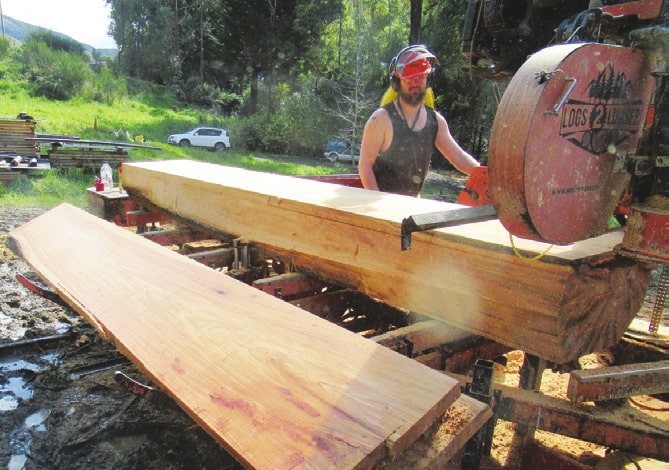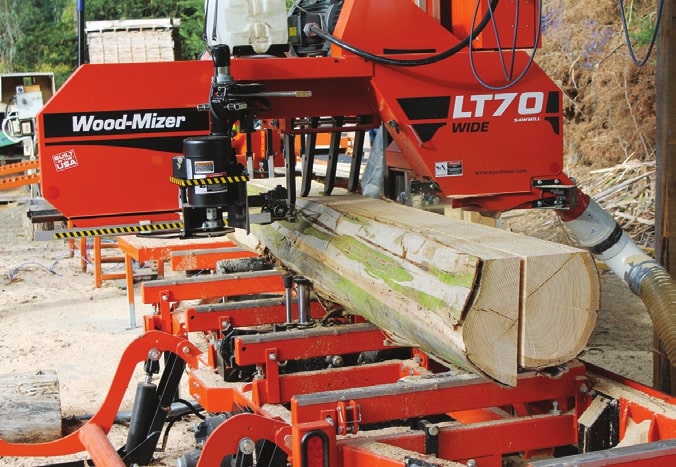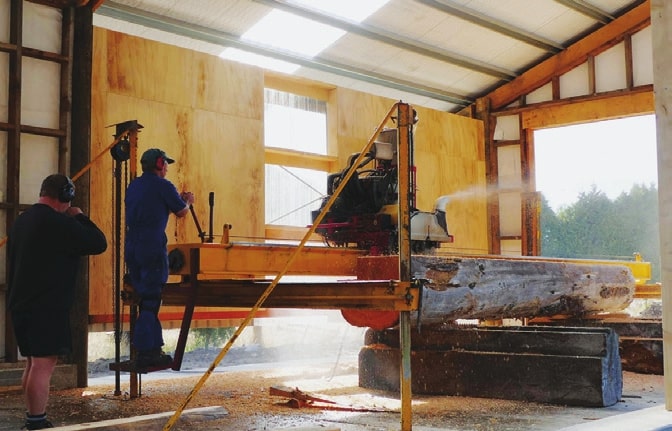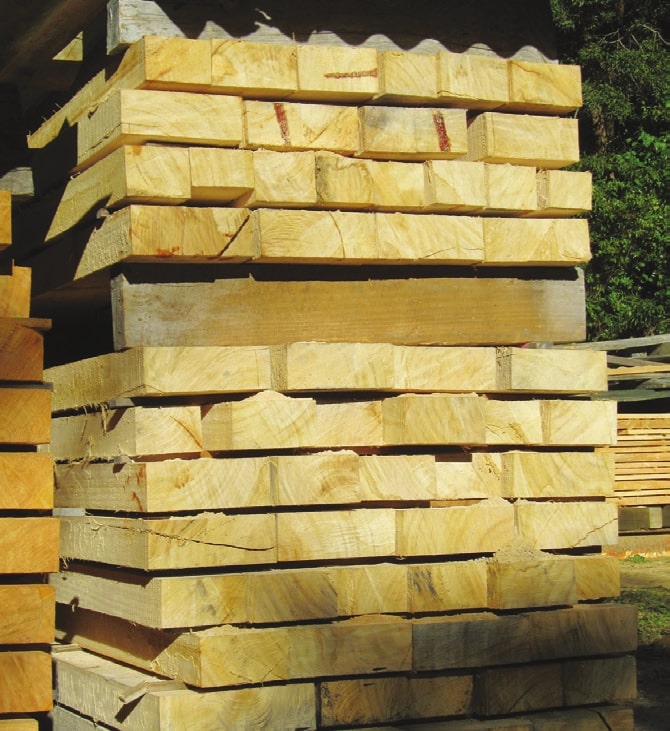
This is free.
The current value and future potential of the small-scale sawmilling sector
Paul Millen and Harriet Palmer, New Zealand Tree Grower November 2020.
New Zealand’s current small-scale sawmilling sector is made up of a diverse mix of businesses and individuals who produce specialty timbers for high-value markets.
This includes a small number of growers of alternative species who are also sawmillers although most growers struggle to sell logs locally.
New Zealand’s current small-scale sawmilling sector is made up of a diverse mix of businesses and individuals who produce specialty timbers for high-value markets. This includes a small number of growers of alternative species who are also sawmillers although most growers struggle to sell logs locally.
Increasing the capability of the small-scale sawmilling sector would improve the local log market for growers. It would also contribute to regional economic development by increasing the supply of local specialty timbers, generating employment, adding value to a primary resource, and reducing reliance on imported timbers. The Hawke’s Bay Regional Council recently commissioned a report on the potential for a sustainable regional industry based on small-scale sawmilling of locally grown alternative timber species.
History of use of small sawmills
New Zealand has a long history of development and use of small-scale sawmills often referred to as portable or mobile sawmills. This started with the early bush sawmills in native forests in the late 1800s through to the design and manufacture of various portable sawmills throughout the 1900s. It continued with the widespread use of modern chainsaws in the 1950s including for milling large logs into slabs using Alaskan mills.
The stimulus for development and use of the modern small sawmills now operating throughout New Zealand occurred during the 1970s and 1980s. Over these two decades the production of native timber from publicly owned forests declined dramatically until logging ended in publicly owned native forests in 1993.
Native forest logging on private land also became more regulated and only single trees or small groups can now be felled. The former Forest Service started planting alternative exotic timber species in the 1970s to replace the decline in native timber. The Forest Service continued this until its dissolution in 1987 leaving many small areas of alternative species throughout their forests. These forests were sold in the early 1990s to companies which have either harvested the alternative species and replanted in pine or have left them standing due to limited market options.
From its establishment in 1957, the NZFFA encouraged planting a range of alternative species and this continues to the present day. Throughout New Zealand there are members with maturing small woodlots of alternative species with a few undertaking small-scale sawmilling and marketing of specialty timbers although many more cannot find a market for their logs.

Manufactured in New Zealand
New Zealand has more than its fair share of manufacturers of small-scale sawmilling equipment. The decline in native log supply combined with interest in growing alternative exotic timbers sparked innovation by New Zealand engineering firms and led to the design and manufacture of several makes of mills. These include:
- Peterson Portable Sawmills in Rotorua
- Mahoe Sawmills in Kerikeri
- Turbo Sawmills in Tauranga
- Rimu Engineering, no longer in business.
Peterson, Mahoe and Rimu all started development and production of circular multi-blade and swingblade portable mills in the 1980s. These New Zealand designed and manufactured mills became popular here as well as in other countries. Their success was followed by Turbo Sawmills, a Tauranga-based company, starting up in 2007. Numerous custom-built mills are also operating. Currently a range of Peterson, Mahoe and Turbo sawmill models and accessories are produced and sold in New Zealand and are also exported to many other countries.

Imported into New Zealand
Wood-Mizer portable band sawmills were developed for sawing high-value US native hardwoods in the early 1980s. Early Wood-Mizer models were imported into New Zealand soon after and this continues.
Following the early import and promotion of Peterson swing blade sawmills in Australia, a similar portable mill design was developed in 1994 by an Australian company Lucas Mills and these mills are also imported as are a number of other sawmills. All the mills described above are designed to be portable or mobile, but some millers prefer to operate from a permanent base, with logs transported from the forest to the sawmill.
All manufacturers produce a range of different models and accessories. Small manual sawmill models range in price from $6,000 to $12,000. At the top end of the range there are commercial multi-saw models with power feed and computer management that cost around $20,000 to $25,000. Commercial band-saw models with power feed, computer management and hydraulic log handling can cost between $60,000 and $120,000 depending on the model and the exchange rate.

The number of small-scale sawmillers
Feedback from the main small-scale sawmill companies in New Zealand helped in producing the following estimates of the numbers of sawmills sold in New Zealand over the past 30 to 40 years, and the level of use of these mills. The data suggests that over 1,100 small sawmills have been sold in New Zealand, many of which are in use full-time or part-time.
| Make of sawmill | Numbers sold in New Zealand to March 2020 | Estimate of use by owners |
|---|---|---|
| Peterson | 446 | 10 per cent full time 20 per cent regular 40 per cent occasional 30 per cent rarely or never |
| Turbo | 60 to 100 | 10 per cent full time 80 per cent part-time 10 per cent rarely |
| Mahoe | Not available | Not available |
| Rimu | 137 until business ceased | Not available |
| Wood-Mizer | 150 | 50 per cent full time; 40 per cent part-time, 10 per cent occasional |
| Lucas | 371 | Not available |
| Total sawmill sales | 1160 to 1200 |
Current and potential future value
There has been no research into the overall economic contribution made by New Zealand’s small-scale sawmilling sector, in terms of manufacturing and sales of mills, the numbers of businesses operating, the volume and value of timber produced and sold and the employment generated by the sector. There is published data on the volume and value of native timbers sawn in New Zealand but there is none on exotic alternative species.
The only register of small-scale sawmillers is held by the Ministry for Primary Industries and consists of about 140 operators who have a licence to mill native timber.Some sawmillers operate bandsaws such as Wood-Mizers from a permanent base, and as their bread and butter they mill radiata pine to produce material such as weatherboards and timber for joinery while also milling alternative species. Other sawmills focus almost solely on one or two species, often cypress, and the gradual decline in availability of this species has led to a number of sawmills closing down in recent years, jeopardising the value chain for that region.

Opportunities
New Zealand imports around 72,000 cubic metres of timber every year, worth over $120 million. Much of this imported timber goes into high-value end uses, and could be replaced with locally grown specialty timber if the capability of the small-scale sawmilling sector increases.
Based on a series of relatively conservative assumptions outlined in the Hawke’s Bay report, New Zealand’s small-scale sawmillers may be producing up to 80,000 cubic metres of green-sawn timber per year. If the wholesale value of this sawn timber is assumed to be $1,000 a cubic metre, then the industry is already producing over $80 million worth of timber annually.
This timber is sold into many local markets displacing imported timber. However, some is used on farms or by the forest grower for domestic projects, while some timber may sit for many years due to problems with sales.
The 1990 and 2000 plantings are maturing and could significantly increase the supply of alternative species for harvest over the next decade or two. The opportunity for more New Zealand grown timbers to replace imported timber exists. With help, this could be fully exploited. One option is to improve the capability of the small-scale sawmilling sector.
The Hawke’s Bay perspective
| Species | Age class in years | Total area in hectares | |||
|---|---|---|---|---|---|
| 1 to 10 | 11 to 20 | 21 to 30 | Over 30 | ||
| Douglas-fir | 63 | 65 | 163 | 154 | 445 |
| Cypress | 20 | 289 | 38 | 21 | 368 |
| Other softwoods | 312 | 186 | 172 | 247 | 917 |
| Eucalypt | 690 | 151 | 9 | 111 | 961 |
| Other hardwoods | 172 | 65 | 91 | 171 | 499 |
| Total area in hectares by age class | 1,257 | 756 | 473 | 704 | 3,190 |
Hawke’s Bay Regional Council is currently involved in assessing the potential for a regional scale forestry project under the principles of the right tree in the right place. As part of this, the potential for planting alternatives to radiata pine was reported to explain how different species align with the region’s main objectives of reducing soil erosion and creating an economic resource.
This project also highlighted that there was an existing regional resource of alternative species. This generated interest for investigating the potential of small-scale sawmilling based on portable mills to operate in the region and prompted the report on which this article is based. According to the National Exotic Forest Description, Hawke’s Bay currently has 3,190 hectares of alternative species. It is important to note that the National Exotic Forest Description data only records areas over one hectare in area and fails to identify species except in very broad categories.
Alternative species woodlots in Hawke’s Bay are widely scattered on farms and as part of large corporate forests throughout the region. They consist of at least 40 different species. Some of these trees are mature, others will come on stream in the next couple of decades. The age profile of the Hawke’s Bay resource seen in the table is typical of many other parts of New Zealand.
Too few mobile mills
Currently, the existing small-scale sawmillers cannot increase their demand for logs to match the potential supply from these forests. As a result, we are seeing mature stands being sold by growers for log export. The best and perhaps only way to extract any regional added value from these maturing alternative species will be if the small-scale sawmilling sector is increased to produce a mix of sustainable regional value chains located throughout New Zealand.
These could be based on sawmillers operating from a permanent base near to where the trees are growing, or a mobile operator who offers an on-site service. Once milled, dried and perhaps re-sawn, any timber not used on the farm could be sold at prices which attract buyers and generate acceptable returns for growers.
The Hawke’s Bay report estimates that one smallscale sawmilling business operating at a permanent base and milling softwoods would require 3.4 hectares of mature forest each year to operate sustainably, producing around 675 cubic metres of sawn timber a year. A similar hardwood sawmiller would need 2.25 hectares a year of mature hardwoods and produce 450 cubic metres of sawn timber per year. A mobile operation would need less than half these areas to operate sustainably.
Based on the assumption that half of all Hawke’s Bay alternative species trees are accessible and available to harvest, indicative calculations suggest that the existing resource could sustainably support at least seven fulltime sawmills operating from a permanent base. This would require a lot more work establishing value chains, but it is an initial indication of a level of increased capability needed for the current area of alternative species to be sawn locally.
Information gaps identified
The Hawke’s Bay report confirmed what many of those involved in the alternative or specialty species sector already suspected. It is that there are two major factors affecting the sector and holding back further development.
One is the lack of accurate data about the alternative species resource which is a significant constraint for those already operating within the industry, anyone hoping to invest in it, and for any modelling of the potential economic contribution of the alternative species resource. A new inventory system is needed.
The more accurate the data in terms of location, area, species, quality, accessibility and owner’s objectives around harvesting, the better the chance of developing sustainable value chain in the regions. The other factor relates to the number of portable sawmillers in New Zealand. There is significant potential to establish an industry association for this sector. This could encourage greater industry participation by providing members with technical support, education and training, co-ordinated branding and marketing high-quality locally grown alternative species timbers and many other potential types of support.
Farm foresters and other small-scale growers generally plant alternative species in the hope of accessing a high-value market when the trees are ready for harvest. While some have had success in marketing or otherwise using alternative timbers, others have been sorely disappointed.
One positive result from the Hawke’s Bay study is that two new projects were initiated for the Specialty Wood Products Research Partnership. One is a survey of small-scale sawmillers, as a first step towards establishing an industry association for the sector. The other is work to develop and pilot a new accurate inventory method for alternative species forests. Both projects are making good progress, and there will be articles about these projects in upcoming issues of the Tree Grower.
Acknowledgements The work was funded by the Hawke’s Bay Regional Council, Hawkes Bay Regional Investment Company and the Specialty Wood Products Research Partnership. The latter is part of Forest Growers Research and receives funding from MBIE, the Forest Growers Levy Trust, and industry partners.
Paul Millen is Project Manager, NZ Dryland Forests Initiative and Harriet Palmer is an independent forest communications specialist.

 Farm Forestry New Zealand
Farm Forestry New Zealand

